new posts in all blogs
Viewing: Blog Posts Tagged with: Manhattan, Most Recent at Top [Help]
Results 1 - 17 of 17
How to use this Page
You are viewing the most recent posts tagged with the words: Manhattan in the JacketFlap blog reader. What is a tag? Think of a tag as a keyword or category label. Tags can both help you find posts on JacketFlap.com as well as provide an easy way for you to "remember" and classify posts for later recall. Try adding a tag yourself by clicking "Add a tag" below a post's header. Scroll down through the list of Recent Posts in the left column and click on a post title that sounds interesting. You can view all posts from a specific blog by clicking the Blog name in the right column, or you can click a 'More Posts from this Blog' link in any individual post.

By: Cassandra Gill,
on 9/14/2016
Blog:
OUPblog
(
Login to Add to MyJacketFlap)
JacketFlap tags:
Central Park,
History,
new york,
America,
park,
Manhattan,
playground,
reservation,
*Featured,
Online products,
New York City History,
Frederick Law Olmsted,
Oxford Research Encyclopedia of American History,
Board of Commissioners,
Building Central Park,
Calvert Vaux,
digital environment,
manhattan 19th century,
parks in urban America,
Add a tag
The site chosen for Central Park was distant from the built area of the city: the cost of Manhattan real estate precluded buying land for a large park in the densely built lower part of the island, and this would be true in other cities as they acquired land for parks throughout the remainder of the century. Still, the process of assembling land for park purposes was a visionary accomplishment, removing 9,792 standard 25 × 100 foot Manhattan building lots and reserving them for public use.
The post Building Central Park appeared first on OUPblog.

By: John Priest,
on 9/9/2016
Blog:
OUPblog
(
Login to Add to MyJacketFlap)
JacketFlap tags:
9/11 anniversary,
9/11 ground zero,
Harriet F. Senie,
memorials to shattered myths,
Reflecting Absence,
September 11 Memorial Museum,
september 11th memorial,
september eleventh,
tribute in light,
New York City,
9/11,
memorial,
memorials,
battery park,
september 11th,
September 11,
Manhattan,
ground zero,
*Featured,
Art & Architecture,
9/11 memorial,
september 11 memorial,
Arts & Humanities,
Add a tag
Reenactment, it seems, defines our memorial experience, but isn’t it time to refocus on lessons learned?
The post Fifteen years after 9/11 appeared first on OUPblog.

By: Celine Aenlle-Rocha,
on 9/15/2015
Blog:
OUPblog
(
Login to Add to MyJacketFlap)
JacketFlap tags:
Books,
Music,
tourism,
Manhattan,
musical theater,
times square,
Hard Times,
body art,
street performers,
painted ladies,
*Featured,
Theatre & Dance,
Elizabeth L. Wollman,
New York history,
desnudas,
Flo Ziegfeld,
The Adult Musical in 1970s New York City,
Add a tag
Because nothing noteworthy occurred anywhere in the world through the month of August and the first half of September, the local news in New York City turned its attentions to a few women who have apparently been bothering people in the otherwise calm, decent section of Manhattan known as Times Square.
The post The desnudas of Times Square appeared first on OUPblog.

By: Mohamed Sesay,
on 7/16/2015
Blog:
OUPblog
(
Login to Add to MyJacketFlap)
JacketFlap tags:
Books,
Music,
new york,
national anthem,
Woody Guthrie,
Manhattan,
folk music,
This Land is Your Land,
*Featured,
Folk City,
Moe Asch,
New York and the American Folk Music Revival,
Ron Cohen,
Stephen Petrus,
Add a tag
Seventy-five years ago folk singer Woody Guthrie penned the initial lyrics to “This Land Is Your Land,” considered by many to be the alternative national anthem. Sung in elementary schools, children’s summer camps, around campfires, at rallies, and during concert encores, “This Land Is Your Land” is the archetypal sing-along song, familiar to generations of Americans. But what most do not know is that Guthrie, the “Oklahoma Cowboy,” actually wrote the song in New York and that its production and dissemination were shaped by the city’s cultural institutions.
The post This land is your land appeared first on OUPblog.
I've been re-reading 'The Time Machine' and today feels very much like I've taken a trip back in time.
Today I scanned the negatives of the photos I took of my NYC apartment at 161 W. 78th Street back when I went to Parsons in the last century. It was so cool to recognize and revisit everything in that room. It was just like being a time traveler - I wondered at the objects I'd forgotten and remembered.
Some of the circled treasures are: my radio and toaster (that I'd hauled from Utah to Seattle and now to NYC). My cup hanging from a wire (to keep the roaches off), the mini-stove (sitting on top of the mini fridge), my tea kettle and my illustration in progress.
Everything but the bed was scrounged off the streets. You'd never guess how attached one can become to an old second hand toaster and radio.
But it was when I looked at the window at the view that I signed the lease without a doubt. The Museum of Natural History is just down the block. It was such an adventure to just look out the window in the mornings watching people going to work.
By: Stacy Dillon,
on 7/13/2014
Blog:
Welcome to my Tweendom
(
Login to Add to MyJacketFlap)
JacketFlap tags:
thriller,
Dial Books for Young Readers,
Manhattan,
2014,
socio economic class,
Staten Island,
The Met,
Friendship,
WWII,
art,
Mystery,
Add a tag
Theodora Tenpenny may live in Manhattan, but it's not a glamorous existence for her. She lives in a ramshackle house with her absent minded math genius mother and her grandfather Jack. But right on page 4, Jack is killed and leaves Theo only with the dying message of "Look under the egg."
Not much for a 13 year old who is trying to keep it together to go on. So between gardening, taking care of her chickens and pickling for food, scanning the streets for useful objects and caring for her mother, Theo needs to unravel what her grandfather's wishes were.
Theo is up in her grandfather's art studio one day trying to figure out the mystery when a mouse runs up her leg and she jumps up and spills some rubbing alcohol on one of Jack's paintings - the painting unlike his other paintings. The egg. As Theo desperately tries to clean the rubbing alcohol off, the colors smear and smudge and she is devastated at losing this last bit of Jack. But when she looks closely she realizes that under the egg, a different painting is revealing itself. Could this be what Jack's dying words were about?
Theo is at a neighborhood diner owned by a friend of Jack's where she forms an unlikely friendship with Bodhi - another 13 year old who has just moved down the block and happens to have Hollywood parents. Where Theo's existence is positively Little House on the Prairie, Bodhi's is the Jetsons in comparison. Theo surprisingly lets Bodhi in on the secret painting, and soon with Theo's art history knowledge and Bodhi's internet skills, they are on the trail to the truth.
Woven into the text are explanations of fine art, as well as bits of history involving WWII. There are also real life bits of NYC living including the Staten Island Ferry, Grace Church, the Met and the Jefferson Market Library. All of these true things had me actually google
Spinney Lane to see if it was one of those Manhattan streets I've walked by a million times but not walked down.
This is a solid summer mystery with a really fantastic sense of place.
By: Grant Overstake,
on 8/14/2013
Blog:
(
Login to Add to MyJacketFlap)
JacketFlap tags:
Uncategorized,
YA Fiction,
Kansas,
Chicken Soup for the Soul,
Sports Stories,
Manhattan,
Guideposts,
Girls Sports,
Grant Overstake,
Inspirational Sports Stories,
Maggie Steele,
young adult sports,
Kansas State Track and Field Championships,
Kansas Farm Life,
sports novels,
Recommended sports books for teens,
wholesome reading,
Kansas Book Festival Authors,
Nancy Julien Kopp,
Wholesome Teen Fiction,
Writer Granny's Blog,
Add a tag
One of America’s most inspirational writers has discovered a satisfying new source of inspirational reading: “I spent two evenings reading Maggie Vaults Over the Moon and this long-time adult enjoyed the story immensely,” writes Nancy Julien Kopp. “Maggie is a … Continue reading →
Run - don't walk - to get
 Joe Golem and the Drowning City
Joe Golem and the Drowning City by Mike Mignola and Christopher Golden,
especially if you like steampunk.
I've recommended Christopher Golden's books here at readergirlz many times, and for good reason: his stories rock, and they often feature a strong female protagonist. In the heart of Manhattan, you'll find 14-year-old
Molly McHugh. Described as "all freckles and red hair and youthful vigor," Molly is a force to be reckoned with. The girl's got moxie, and she can certainly hold her own. She trusts her gut, which has helped her to survive in the Drowning City.
Just what has happened to the once-glorious city? Here's a little backstory:
Fifty years ago, earthquakes shook Lower Manhattan, submerging the city and forever changing the landscape and livelihood of all who lived there. As the years passed, the gap between the classes widened: the wealthy live and thrive in Uptown, where they grow wealthier, as the poor people in submerged Downtown try desperately to survive in what is now known as the Drowning City.
It is in Downtown that aging magician Felix Orlov resides. Molly, his energetic and devoted assistant, lives the floor above him. Dark dreams, a seance, and an attack lead to Orlov's abduction and cause Molly to run away - and enlist the help of Simon Church, an investigator, and Joe Golem, the bodyguard to end all bodyguards. If Hellboy were mixed with Eliot Spencer from
Leverage and dressed in clothes from some classic Warren Beatty films, he might just be Joe Golem.
Christopher Golden and Mike Mignola make me want to live in the Drowning City, to meet the wonderful characters they've created and help them defeat the monstrous villains. They've also offered up a short story,
Joe Golem and the Copper Girl, but I still want more. Mignola's black-and-white illustrations are, as always, memorable. One only hopes that the movie, which is currently in development, captures the spirit and intensity of this book. The submerged city, falling buildings, and fight scenes need to be
Inception-level awesome on screen. This captivating story deserves all of that, and more. I also recommend this novel to fans of
Fringe. (Hello, Manhattan and alternate history!)
Want to know more? Read my full review at my blog, Bildungsroman.

By: Kirsty,
on 11/16/2011
Blog:
OUPblog
(
Login to Add to MyJacketFlap)
JacketFlap tags:
Sociology,
nyc,
new york,
Current Affairs,
Geography,
protest,
Manhattan,
abercrombie,
fitch,
Naked City,
Sharon Zukin,
michael bloomberg,
fifth avenue,
*Featured,
Law & Politics,
Occupy Wall Street,
Zuccotti Park,
zuccotti,
Add a tag
By Sharon Zukin
Until the early morning of November 15, a few hundred Occupy Wall Street protesters spent the chilly nights of a glorious autumn camping out in Lower Manhattan’s Zuccotti Park. Despite Mayor Michael Bloomberg’s disapproval with their politics and under the New York City Police Department’s anxious eye, the occupiers captured public attention in a remarkably peaceful way. Regrouping for the winter, they will take stock of what they have achieved so far and the work that remains.
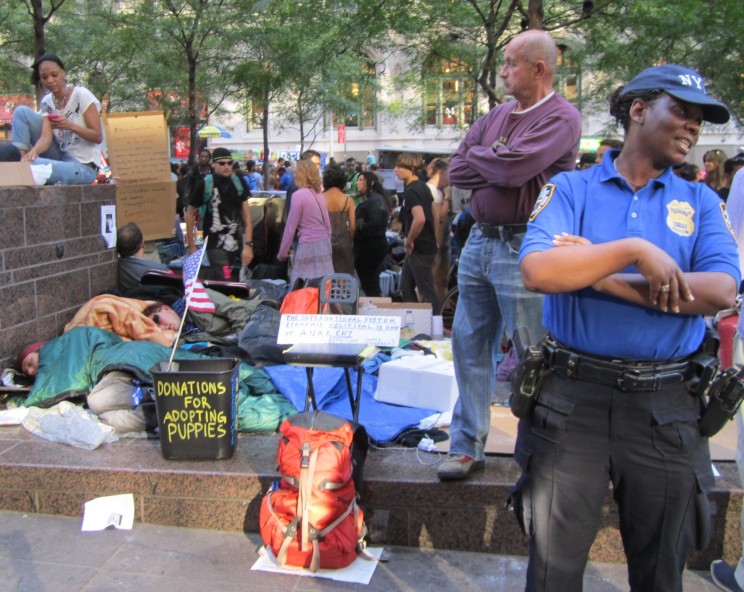
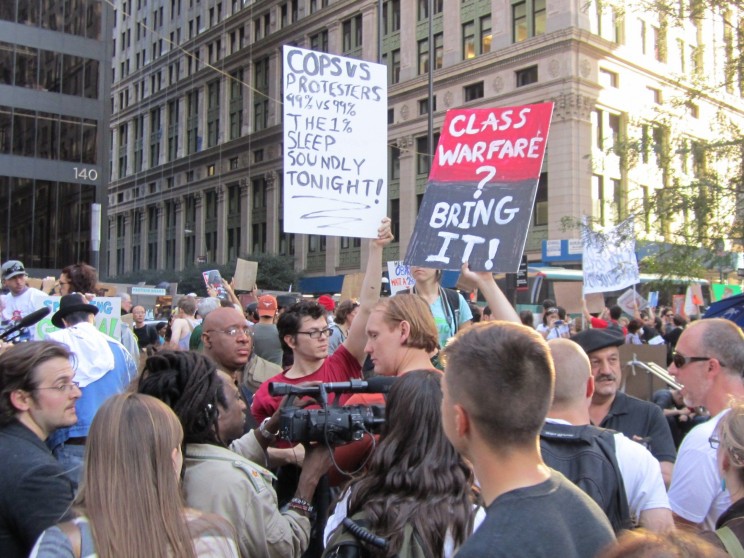
Though the occupation was initially ignored by mainstream media after it began in September, the protest movement attracted favorable attention both nationwide and internationally. Arrests flared in other U.S. cities, notably Oakland, California, where protesters tried to recall a famous general strike of 1946 by marching to the port. But unlike in Oakland, and Portland, Oregon, the encampment at Wall Street survived the constant threat of being rousted by police action on the one hand and cold weather on the other without death, disaster or dishonor.
An official order to clear Zuccotti Park was squelched in October by the intervention of local city council members and other politicians—some of whom, not coincidentally, plan to run for office in the 2012 elections. Many local labor unions support the movement, suggesting that alliances may be possible across “police and firefighter” lines. This kind of alliance recently won a referendum in Ohio overturning a state law that would have limited public unions’ collective bargaining rights.
In Zuccotti Park protesters formed a tiny city within the city. Food, clothing and books were donated and handed out. Electric generators that were confiscated by the fire department were returned after volunteer attorneys complained on the protesters’ behalf. For public safety the occupiers relied on volunteer security guards who used nonviolent techniques to confront, isolate and occasionally expel troublemakers. Women and transgender protesters could, if they wished, sleep in separate tents. Before November 15, few people were arrested by the police for allegedly committing sexual or physical assault.
New Yorkers quickly became accustomed to this remarkably peaceful microcosm of urban life. On sunny weekend afternoons tourists thronged Zuccotti Park and its celebrated neighbors, the World Trade Center site on one side and the financial district on the other. I have never seen Lower Manhattan look more vibrant.
But Occupy Wall Street was only one of Manhattan’s tourist attractions. To put support for the movement’s proposed reforms in a realistic perspective it is suggestive to look at other sites in the city and the desires that they apparently fulfill.
Nearly 50 million men and women are visiting New York City this year. Nearly 50,000 of them ran in the recent New York City Marathon sponsored by ING Bank .
While protesters occupied Zuccotti Park in tents, the average price of a hotel room in New York City is $250 and the hotel occupancy rate is
0 Comments on Memo from Manhattan: Occupying Wall Street—and Fifth Avenue as of 1/1/1900

By: Maryann Yin,
on 3/3/2011
Blog:
Galley Cat (Mediabistro)
(
Login to Add to MyJacketFlap)
JacketFlap tags:
HarperCollins,
Brooklyn,
Publicity,
Manhattan,
Harper Perennial,
Blake Butler,
entierty,
HTML Giant,
Lamination Colony,
marathon readings,
No Colony,
There is No Year,
Add a tag
 On four different nights, novelist Blake Butler will host a marathon reading of his new book, There Is No Year. Held in four different locations, a team of New York writers will help read the complete novel.
On four different nights, novelist Blake Butler will host a marathon reading of his new book, There Is No Year. Held in four different locations, a team of New York writers will help read the complete novel.
Click on the image embedded above for the dates and exact locations. Participants include: “Ben Greenman, Emma Straub, John Dermot Woods, Justin Taylor, Jo Weldon, Rachel Shukert, Melissa Broder, Jonny Diamond, Adam Robinson, Dorethea Lasky, Shya Scanlon, Lincoln Michel, Butler and his own editor [at] Harper Perennial, Cal Morgan.”
Butler edits the literary blog HTML Giant and two journals, Lamination Colony and No Colony. In 2009, he published a novella called Ever.
New Career Opportunities Daily: The best jobs in media.

By: Lauren,
on 9/23/2010
Blog:
OUPblog
(
Login to Add to MyJacketFlap)
JacketFlap tags:
high line park,
outdoor spaces,
public parks,
Sociology,
New York City,
A-Featured,
bloomberg,
Manhattan,
Sharon Zukin,
Add a tag
By Sharon Zukin
Shortly before 8 p.m. on a warm September evening the High Line, Manhattan’s newest public park and the only one located above street level, is crowded. Men and women, old and young, tourists from overseas and longtime New Yorkers have climbed the winding metal stairs to the former railroad freight line, now a mile-long, landscaped walkway, just to view the sunset over the Hudson River. There are more people up on the High Line than down on the streets. They are taking photos, chatting quietly, lounging on wooden benches and strolling between shallow beds of native plants, creating a new passagiata for the post-industrial city.
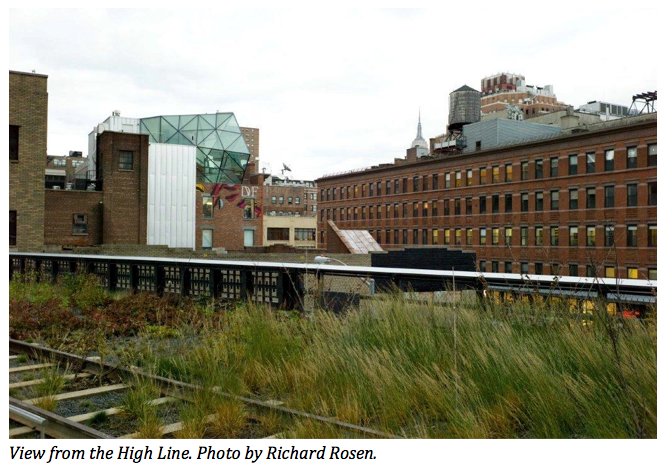 There’s a lot to like about the High Line. It’s a gritty fragment of New York’s industrial past that was saved from demolition by feisty activists and wholesome volunteers. It makes us think about how the city’s architecture was once built for function rather than for style. It reminds us of what the rough West Side of Manhattan was like before a derelict Nabisco plant, where assembly line bakers manufactured the first branded American cracker, was transformed into the high-class bread shops of Chelsea Market. And it recalls the days, not so long ago, when the Meatpacking District was a no-go zone for animal carcasses, blood-stained butchers and several kinds of street workers who made their nocturnal rounds, a far cry from the attraction for club kids and fashionistas it has become.
There’s a lot to like about the High Line. It’s a gritty fragment of New York’s industrial past that was saved from demolition by feisty activists and wholesome volunteers. It makes us think about how the city’s architecture was once built for function rather than for style. It reminds us of what the rough West Side of Manhattan was like before a derelict Nabisco plant, where assembly line bakers manufactured the first branded American cracker, was transformed into the high-class bread shops of Chelsea Market. And it recalls the days, not so long ago, when the Meatpacking District was a no-go zone for animal carcasses, blood-stained butchers and several kinds of street workers who made their nocturnal rounds, a far cry from the attraction for club kids and fashionistas it has become.
The High Line offers New Yorkers a novel way to indulge in two things that have become a passion since 9/11: spending time out-of-doors and hanging out in public spaces. Maybe it reflects a hunger for community or maybe it’s a behavioral response to global warming, but this desire to be together in public flouts the ever-present eye of the surveillance cameras and revels in the diversity of strangers. It’s the same passion that drives apartment dwellers to socialize on their building’s roof and eat lunch in the new “traffic-calming” islands that have been carved out of Broadway’s tumult.
While the number of people who use the city’s public parks has grown enormously in recent years, the High Line attracts a disproportionately huge number of visitors, as many as half a million in the first two months after it opened in 2009.
But this is what it took to “save” it: A mayor – Michael Bloomberg – who understands the value of attractive green space to brand the city for tourists and residents alike. A city planning commissioner, Amanda Burden, who shares the city-branding vision and speaks the language of historic preservation. A longtime strategy of “adaptive re-use” to find new business uses for old historic structures and an emerging strategy of “self-financing” for public parks, both of which rely on private funding. Most important, saving the High Line depended on powerful backers in the “creative class” of art, media and fashion who have their own interest in redeveloping the neighborhood—in this case, the power couple of Diane vo

By: Lauren,
on 8/10/2010
Blog:
OUPblog
(
Login to Add to MyJacketFlap)
JacketFlap tags:
Religion,
Politics,
American History,
A-Featured,
9/11,
bloomberg,
muslim,
religious freedom,
Manhattan,
ground zero,
muslims,
world trade center,
edward e. curtis iv,
ground zero mosque,
muslims in america,
pat robertson,
rauf,
mosque,
iupui,
Add a tag
By Edward E. Curtis IV
Like Gettysburg, the National Mall, and other historic sites, Ground Zero is a place whose symbolic importance extends well beyond local zoning disputes and real estate deals. The recent controversy over a proposal to build a Muslim community center two blocks away from the former World Trade Center shows it clearly: the geography of Lower Manhattan has become a sacred ground on which religious and political battles of national importance are being waged.
After New York’s Landmarks Preservation Commission gave its approval for the demolition of the building now located on 45-47 Park Place in Lower Manhattan, the Rev. Pat Robertson’s American Center for Law and Justice announced that it is suing to stop the project.
Though Robertson’s organization is supposedly dedicated to the “ideal that religious freedom and freedom of speech are inalienable, God-given rights,” it is not primarily concerned with religious rights, at least not the rights of Muslims. It is instead part of a loose coalition of Americans who have identified the presence of Muslims, both at home and abroad, as a primary threat to both the United States and the Judeo-Christian heritage.
Their Muslim-bashing has deep roots in American history. Since the days of Cotton Mather, the New England Puritan minister, many Americans have associated Muslims with religious heresy. In the early 1800s, as the United States waged its first foreign war against the North African Barbary states, politicians, ministers, and authors regularly used themes of oriental despotism, harems, and Islamic violence in political campaigns, novels, and sermons.
Later, when the U.S. failed to quell Muslim revolts during the U.S. occupation of the Philippines in the early twentieth century, U.S. Army Gen. Leonard Wood called for the extermination of all Filipino Muslims since, according to him, they were irretrievably fanatical.
Islamophobia, an odd combination of racism, xenophobia, and religious bias, receded in importance during the 1900s as the specter of communism replaced it as a primary symbol of foreign danger. But with the fall of the Soviet Union, stereotypes about the Islamic “green menace” have once again become a central aspect of our culture.
This time Muslims are fighting back. Their civil rights and religious leaders are challenging this old American prejudice, in part through unprecedented interfaith community activism. Imam Feisal Abdul Rauf, the leader of the group proposing the Muslim community center near Ground Zero, is one of them.
In response to questions about why he wants to build a community center so close to Ground Zero, Rauf has said that he wants the community center to be a source of healing, not division. Rauf also pledged that Park51, as the project is now called, will be a “home for all people who are yearning for understanding and healing, peace, collaboration, and interdependence.”
Rauf has powerful friends–or at least allies. New York Mayor Michael Bloomberg, who choked up defending the right of Muslims to build the community center during a speech in the shadow of the Statue of Liberty, argues that “we would be untrue to the best part of ourselves…if we said ‘no’ to a mosque in Lower Manhattan.”
Those who agree with Mayor Bloomberg represent the other major faction struggling for the American soul at Ground Zero. For them, the American soul is imperiled when its founding ideals are cast aside. In this case, the ideal is the first amendment guarantee of the free exercise of religion. “Of all our precious freedoms,” said Bloomberg,

By: LaurenA,
on 4/7/2010
Blog:
OUPblog
(
Login to Add to MyJacketFlap)
JacketFlap tags:
fiction,
The,
College,
80,
Manhattan,
Robert,
Geraci,
Rokk,
level,
sci,
fi,
Life,
science fiction,
robots,
Technology,
Science,
apocalypse,
A-Featured,
Western Religion,
World,
of,
aliens,
Warcraft,
Second Life,
World of Warcraft,
Leisure,
sci fi,
Second,
AI,
Apocalyptic AI,
level 80,
Manhattan College,
Robert Geraci,
skynet,
The Rokk,
Apocalyptic,
Add a tag
Lauren Appelwick, Publicity
Robert M. Geraci is Assistant Professor of Religious Studies at Manhattan College. In his new book Apocalyptic AI: Visions of Heaven in Robotics, Artificial Intelligence, and Virtual Reality, he examines the “cyber-theology” which suggests we might one day upload our minds into robots or cyberspace and live forever. Drawing on interviews with roboticists, AI researchers, Second Life devotees, and others, Geraci reveals that the idea of Apocalyptic AI is strikingly similar to Judeo-Christian apocalyptic traditions. Here, he shares 10 ways World of Warcraft, one virtual reality game, could help us survive the end of the world as we know it.
1. The dangers will be minimal…level 80 priests can provide universal health care.
President Obama plans to insure 32 million more Americans than are currently protected; but the area of effect healing spells of priests can jump from one person to another, healing them as they become sick and injured without need for hospital visits, insurance payments, etc. This approach to medical treatment has obvious benefits over the constant paperwork that federally mandated insurance will require.
2. When aliens come to take over the planet, they’ll get addicted to WoW and forget what they were doing.
Instead of world domination, aliens will hope to complete all four daily cooking quests for The Rokk. After they’ve already eaten Emeril, they’ll spice up their life with Super Hot Stew and realize that people don’t taste all that good after all.
3. Who needs indoor plumbing? You’re already used to peeing into bottles.
Your guild’s “friendly” three day race to level 80 has given you all the continence you need…and the willingness to do what you must when the time comes.
4. After countless hours of farming for minerals, herbs and animal hides, you’re well prepared for life after subprime mortgages collapse the economy.
Let’s face it, the economy is in shambles and no one knows when it will recover. On the other hand, while toxic mortgage securities provide neither housing nor security, a proper skinner can ensure that all the local children stay warm through the winter.
5. Gnomish engineers will program the robots to like you (though they can’t guarantee proper functioning).
It’s not the Gnomes’ fault that Skynet became self-aware…they didn’t think it would defend that off switch so vociferously! And to compensate, they’ll happily upload your mind into one of their inventions so that you can join the robots in their post-apocalyptic future.
6. As the value of the dollar declines, gold and mithril will remain safe investments.
Gold will shine through the darkest of times and foreign governments will always be content to buy it from you at the auction house.
7. Your family pet can take aggro for you while you lay a fire trap to destroy a zombie mob.
A lifetime of treats and petting repaid in one priceless moment.
8. Your potions of underwater breathing will let you grab the a
Otherwise known as: A Couple Yankees Head South. Before we could hit the road for Raleigh, Mx had a couple finals to take. I went to the Antique Cafe for an awesome cup of coffee and then took in some of the student exhibits at FIT.
One of the Exhibits highlighted the history of and special attractions in Chelsea:

Art from The High Line

The history of the International Ladies Garment Workers Union in Chelsea

The Museum at FIT [closed on Mondays]

Student Designs>

Finals are OVER!
California here we come. After one last stop at Mx's apartment we took the Lincoln Tunnel out of Manhattan and headed south!
Here are some scenes from the road:



We arrived pretty late in Raleigh and to be honest we FELL into bed at the Best Western in town. We had spent about 8 hours laughing and talking and singing. Watching the world go by. When all was said and done we'd gone through 6 states: New York, New Jersey, Delaware, Maryland, Virginia and North Carolina. It was heaven to drive into North Carolina. We were a bit challenged when it came to photographing all the state signs. Seems like they came upon us so fast. So, we didn't get much of that done, although we intended to. Just too much to talk about, I guess. We also got into the habit of reading FML; and making a road trip song list. Mx introduced me to Red Yellow Sparks and I love them.
Here's an excerpt from my journal from Day One:
"We passed by battlefields and looked up some history--learned that Patrick Henry gave his "Give me liberty or give me death!" speech in Richmond Virginia. Learned that Grant invented the foreshadow of trench warfare when he dug trenches in Petersburg to disturb the supply lines to Richmond and that it took him over a year to do so....One thing we noticed about North Carolina is how many churches there are."
We'd never traveled in The South and were just getting a taste of how The Civil War impacted all the places we would visit. I laid my head down on my pillow and went to sleep to the sound of the men in the room next door cranking country music and talking about the sorry state of it today which moved on to a discussion about their female troubles, angry about something that had happened that night. And, as I writer, I wished the walls were just a little thinner and sleep hadn't come over me so fast.
Click here to see all road trip photos [adding more as I go...]
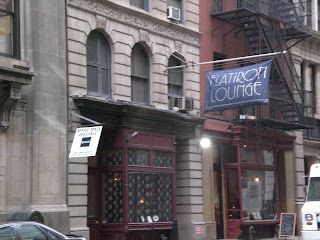 I went to the Flatiron Lounge yesterday to meet the lovely and awesome Taylor Morris and PG Kain. While I was waiting...
I went to the Flatiron Lounge yesterday to meet the lovely and awesome Taylor Morris and PG Kain. While I was waiting...
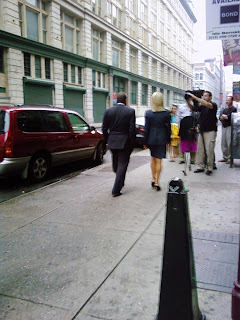 I watched two guys set up a camera and then those two people (newscasters) showed up minutes later. They got directions from the camera guy, "Just walk straight, talk to each other and smile! But start over if someone walks in front of you."
I watched two guys set up a camera and then those two people (newscasters) showed up minutes later. They got directions from the camera guy, "Just walk straight, talk to each other and smile! But start over if someone walks in front of you."
Newsguy and Newsgirl walked a few yards away, then walked back doing their thing. I, of course, took a cell phone pic. They did this four times before they got it and left.
I wonder what THAT segment is going to be about...?
Taylor, PG and I had so much fun and it's so cool to be able to go out with other authors and not talk about writing or books. Oh, no! We had topics of utmost importance to cover, including but not limited to reality TV and Speidi.
Happy weekend!

By: Michelle,
on 3/6/2009
Blog:
OUPblog
(
Login to Add to MyJacketFlap)
JacketFlap tags:
Friends,
Blogs,
new york,
A-Featured,
E.B. White,
Woody Allen,
Today Show,
Manhattan,
Diane Keaton,
Ferris Bueller's Day Off,
Here is New York,
Monica Geller,
Rockefeller Plaza,
Add a tag
Below is another reflection on the life of a publicist from Michelle Rafferty. Rafferty has been a Publicity Assistant at Oxford University Press since September 2008. Prior to Oxford she interned at Norton Publishing for a summer and taught 9th & 10th grade Literature. She is chronicling her adventures in publishing every Friday so be sure to visit again next week.
While growing up in the Midwest my understanding of New York City was formed by shots of Rockefeller Plaza on the “Today Show,” and Monica Geller’s apartment in Friends. At the same time a different, more romantic notion existed in my head, similar to what Woody Allen envisioned when marrying an old and new New York in the film Manhattan: a city that “existed in black and white and pulsated to the great tunes of George Gershwin.” Since moving here 10 months ago, I’ve dispelled my preconceived, romantic notions of New York, learned that Manhattan has more to offer than Rockefeller Plaza, and am now just another commuter with a vacant stare and headphones, unmoved by the subway screeches and jolts I used to find alarming. But in many ways I’m still in awe and I and wonder if I always will be.
In E.B. White’s famous essay, “Here is New York,” he recalls “what it felt likes as a young man to live in the same town with giants”—his giants being those columnists, critics, and poets he idolized as an aspiring writer himself. White writes that being on the same island as them made him burn “with a low steady fever,” and when he walked by the house of F.P.A., “the block seemed to tremble…the way Park Avenue trembles when a train leaves Grand Central.” I myself am constantly in awe at the “big giants” I find myself in proximity with everyday. I have conversations with authors renowned in their respective fields; I’m always one or two degrees separated from the producers, editors and reporters of the publications, radio, and television programs I revere, which makes it difficult at times not to blurt out “I love your work!” And our enormous contact database, well it would be a lie if I said I was never tempted to abuse it.
In my short time here, I’ve learned that on the outside, becoming a New Yorker doesn’t take long: wear all black, don’t advert your eyes, and only carry a map if it can fit into your wallet—better yet, get a Blackberry with access to Google Maps. But what is a New Yorker on the inside? Does amazement have to stop? If it did, why else would everyone continue to cram themselves in such a tiny space? This seems to be what E.B. White is getting at when he wrote, “the city makes up for its hazards and deficiencies by supplying its citizens with massive doses of a supplementary vitamin—the sense of belonging to something unique, cosmopolitan, mighty and unparalleled.” I think that only when this supplementary dose stops taking affect, when amazement has manifested itself in every way possible, a person can leave. And then maybe, nostalgia leads them back to where they came from originally.
In Manhattan, Diane Keaton’s character, Mary, tends to disavow her New Yorker prowess in moments where her intellect and sexuality leave her feeling vulnerable. She says things like, “I’m just from Philadelphia: I mean, we believe in God,” or “I’m from Philadelphia. My family’s never had affairs.” Although Mary’s words are superficial, they are poignant because they show how New York can suddenly make us encapsulate the “virtue” of the places we left behind—whether we believe in that virtue or not. For example, I’m from Indiana where we “watch the fireplace for hours in the winter and take long country road drives in the summer.” Those New Yorkers who truly miss virtues like these return to them. Those who are content with keeping them a romantic notion until the day they die will stay on the island. Or they will continue their search for something else, and maybe even tell their tale of New York to a stranger in a pub along the way. And that stranger will decide they want to take a shot at it. So they come to the city and live their New York story, which is passed along, maybe even in the form of a novel, poem, portrait, or script. That is how I imagine the “greatest city in the world” stays alive. And maybe it is youth tinged optimism, but I hope my own New York story goes on for a long time.



Anyone out there who suffers from the "Write it! Hate It! Erase it! Try Again! Hate it! I Can't Do This Anymore! Leave Me Alone!" Anal Writer's Block Syndrome will surely recognize and identify with the voice in the gorgeous, iconic opening scene of Woody Allen's MANHATTAN. (In other words, see if you can guess what I am doing right now.)
What did Allen Ginsberg say? "I saw the best minds of my generation destroyed by madness, starving hysterical naked" or did he mean destroyed by the BACKSPACE and DELETE buttons?!
Maestro, please:





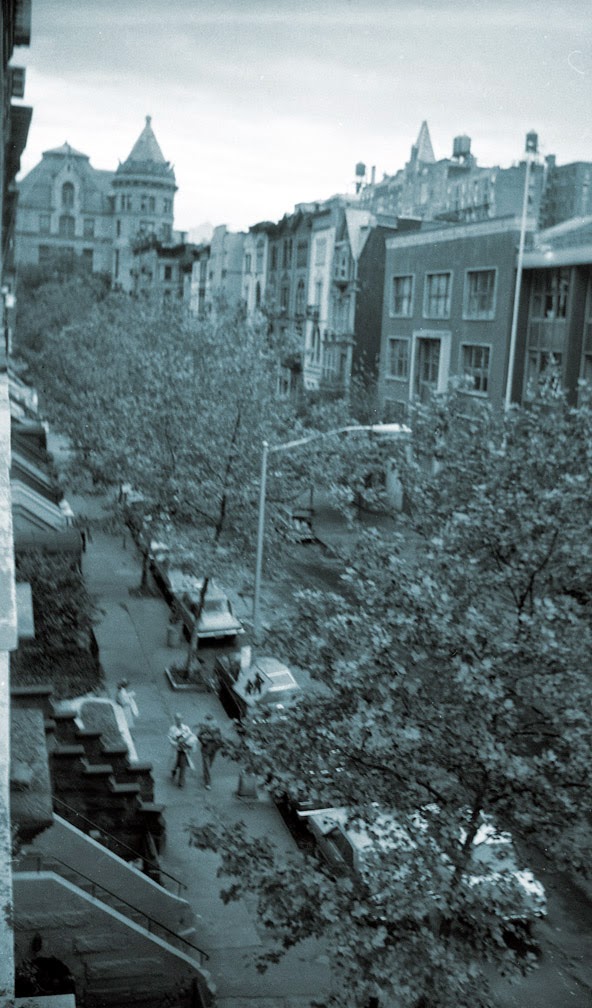

















Wow! What a great endorsement, Grant. Very high praise from an author who knows great writing and a great story.